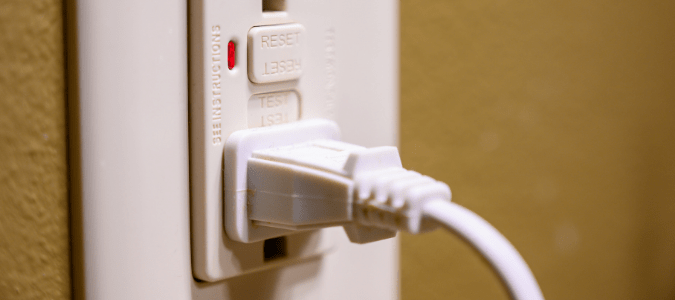
It’s frustrating when you plug something into an outlet and it doesn’t work. Sometimes it’s a small issue that homeowners can easily fix. In other cases, it could also mean you have a bigger problem.
There are a few reasons why GFCI outlets stop working. The outlet might have tripped, there may be a poor electrical connection, the outlet may be defective or the outlet has failed. It’s typically best to contact a licensed electrician to troubleshoot these types of problems. That said, there are some basic steps you might take to try to find out why your outlet isn’t working.
The first step you can take is to check to see if the outlet has tripped. “Tripping” is a built-in safety feature to protect homeowners from electrocution. Each GFCI outlet has a reset and a test button on it. If the reset button has popped out, press the button back in. You can also try pressing the test button first and then the reset button.
If the issue is a tripped outlet, then this should fix the problem and the outlet should start working again. However, if pressing reset doesn’t seem to do anything, then it’s time to contact an electrician. A GFCI outlet that won’t reset could be a sign that there is a ground fault somewhere. This means that the device is defective or has some sort of damage like moisture inside of it or bad wiring. In this case, if the outlet had stayed on when you touched it, then your body could have provided an electrical path from the power source to the ground. This could have resulted in death or severe injuries like shock, burns or electrocution.
A GFCI that resets and then trips again can become quite annoying. That’s why electricians call this “nuisance tripping”. Outlets often continue to trip when they sense a leakage of current. This can happen in a few different situations. For example, if you have too many appliances plugged into the outlet or if you’re using a long extension cord, then your outlet may keep tripping. However, you might be experiencing nuisance tripping if you have a weak, defective or poorly wired GFCI. In this case, you’ll need to have the outlet replaced. A professional can take a look and advise you on what to do next.
Another reason that the outlet might stop working is a poor electrical connection. While this issue is rare, cut wires can keep a GFCI outlet from working properly. Cut wires interfere with the electrical connection and can lead to serious hazards like electrocution and fires.
It’s usually not a good idea to try to replace a GFCI outlet on your own. For starters, safety risks come with any do-it-yourself job related to electricity. On top of that, GFCI outlets must be wired perfectly to work. So, even the handiest homeowners can end up frustrated when working on this kind of project.
A licensed electrician can take care of all the details regarding your GFCI outlets. This way, you don’t have to risk your own safety or that of your family. These pros can identify where the issue is and replace any defective outlets. Best of all, you’ll have peace of mind that it’s set up correctly.
With all this talk of GFCI outlets, you may start to wonder why you even need these types of outlets and how they work. Keep reading to learn more about your home’s electrical system.
How Do GFCI Outlets Work?
As we’ve already discussed, a ground fault circuit interrupter (GFCI) outlet is a type of safety device. GFCI outlets reduce the risk of electrocution and other electricity-related issues. GFCI outlets work by monitoring the amount of current flowing through the circuit. If the level of current returning to the circuit differs even a small amount from the level coming into the circuit, then the GFCI shuts off or trips.
A common cause of electrocution and electrical shock is using tools or appliances near moisture or water. Water particles are excellent conductors of electricity. This is why you typically find GFCI outlets in areas of the home that are in close proximity to water. For example, you’ll see these types of outlets in bathrooms, kitchens, garages, laundry rooms, outdoor spaces and around swimming pools.
Under the National Electrical Code, newly constructed homes must have GFCI outlets in a wide range of these wet areas. Many of these requirements have been in place since the 1970s. So, most homes built in the last several decades should have GFCI outlets in bathrooms and outdoor areas. It’s also important to use GFCI outlets when you’re using tools like drills, hedge trimmers, mowers, sanders or saws.
GFCIs are often built into outlets themselves, but there are other types available as well. For example, you can buy portable GFCI units or extension cords. Also, many circuit breakers have built-in GFCIs to add a level of protection against circuit overload and ground fault. In some cases when your GFCI outlet isn’t working, it can be helpful to check the breaker box. Look to see if a circuit breaker with a GFCI might have tripped or a fuse might have blown.
When it comes to electrical problems, as we have already mentioned, the best route if you have any questions or problems with your outlets (GFCI or not) is to contact a professional. It can be particularly dangerous for a homeowner to attempt to fix issues with GFCI outlets. Any mistake could leave you or a family member with serious injuries.
Not only do these outlets need precise wiring to work, but a malfunctioning GFCI outlet could be a sign of a hazardous electrical problem. That’s why it’s best to contact an electrician if your GFCI does not reset. A pro can fix problems with your GFCI outlet, answer any questions you might have and help ensure your electrical system is safe for you and your family. These pros can also help with bigger projects, such as helping you decide whether you should upgrade your electrical panel.
Of course, like any appliance or tool in your home, there is an average lifespan for GFCI outlets. This means your GFCI outlet might not be working simply because it’s service life has come to an end.
Do GFCI Outlets Go “Bad”?
GFCI outlets typically last an average of five to ten years. But, they can stop working earlier if they aren’t protected and maintained. It’s important to cover any outlet that’s outdoors or in a place with exposure to moisture whenever you aren’t using it. Also, an easy electrical safety tip is to test GFCIs once a month and after events that might damage outlets, such power disruptions or blackouts.
To test an outlet, plug in a lamp and turn the light on, then press the test button on the GFCI. This should make the light go out. Next, press the reset button, which should make the lamp turn back on. If the light doesn’t go out when you press the test button or illuminate when you press reset, you’ll probably want to contact an electrician to make sure your home’s electrical system is working properly.
Recently installed GFCI devices can also stop working if they’re defective. Or, there may be another issue if the outlet was wired improperly or the area is too wet. It’s best practice to place outlets away from tubs. It’s also advised to install a weatherproof cover plate on any GFCI outlet that’s near an appliance that uses a lot of water, such as a dishwasher.
Newer models of GFCI outlets have a self-testing feature with a built-in indicator light. If the light is green, then this typically means that the outlet is working properly. However, if the light is solid or blinking red, then it might indicate some issue with your outlet. A red light could also be a sign of things like bad wiring, a ground fault or a circuit overload.
Another sign that could point to a bad GFCI outlet is physical deterioration. If the outlet is cracked or plugs keep slipping out of it, then it’s likely time to replace the outlet. Damage like cracks could expose the outlet’s electrical wiring and endanger your family or pets.
Even with newer GFCI outlets, homeowners can find it difficult to know whether the outlet is bad or if there is another problem. This is why it’s usually best to get help from a professional when dealing with a GFCI outlet problem.
There are some easy home improvement projects that homeowners can do themselves, but it’s best to have a pro handle any projects having to do with electricity. Licensed electricians have the knowledge and skills to protect you and your loved ones from a wide range of electrical hazards.
ABC Can Get Your GFCI Outlets Working Again
Don’t take any risks when it comes to your home’s electrical system. Let the professionals at ABC Home & Commercial Services use their tools and training to diagnose the electrical issue and quickly get to work on making any needed repairs. Our licensed pros can even take on larger projects, such as replacing your electrical panel.


